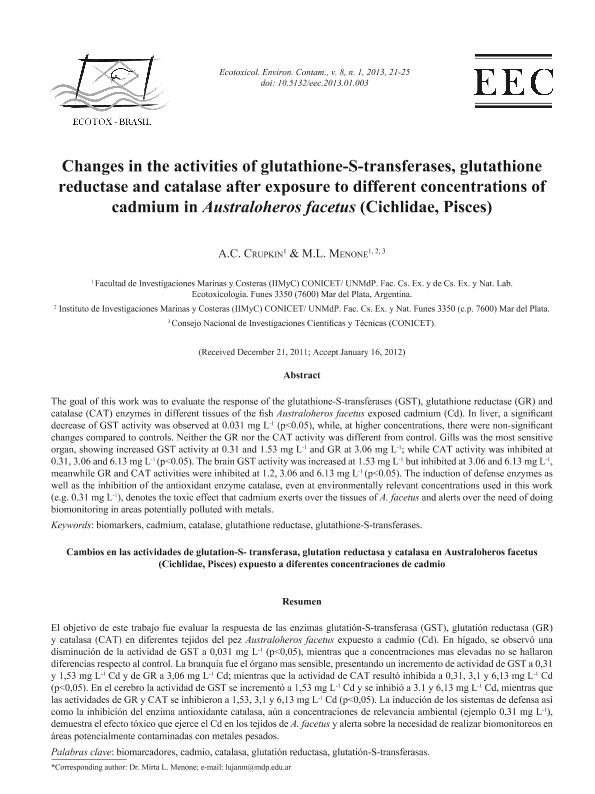Artículo
The goal of this work was to evaluate the response of the glutathione-S-transferases (GST), glutathione reductase (GR) and catalase (CAT) enzymes in different tissues of the fish Australoheros facetus exposed cadmium (Cd). In liver, a significant decrease of GST activity was observed at 0.031 mg L-1 (p<0.05), while, at higher concentrations, there were non-significant changes compared to controls. Neither the GR nor the CAT activity was different from control. Gills was the most sensitive organ, showing increased GST activity at 0.31 and 1.53 mg L-1 and GR at 3.06 mg L-1; while CAT activity was inhibited at 0.31, 3.06 and 6.13 mg L-1 (p<0.05). The brain GST activity was increased at 1.53 mg L-1 but inhibited at 3.06 and 6.13 mg L-1, meanwhile GR and CAT activities were inhibited at 1.2, 3.06 and 6.13 mg L-1 (p<0.05). The induction of defense enzymes as well as the inhibition of the antioxidant enzyme catalase, even at environmentally relevant concentrations used in this work (e.g. 0.31 mg L-1), denotes the toxic effect that cadmium exerts over the tissues of A. facetus and alerts over the need of doing biomonitoring in areas potentially polluted with metals El objetivo de este trabajo fue evaluar la respuesta de las enzimas glutatión-S-transferasa (GST), glutatión reductasa (GR) y catalasa (CAT) en diferentes tejidos del pez Australoheros facetus expuesto a cadmio (Cd). En hígado, se observó una disminución de la actividad de GST a 0,031 mg L-1 (p<0,05), mientras que a concentraciones mas elevadas no se hallaron diferencias respecto al control. La branquia fue el órgano mas sensible, presentando un incremento de actividad de GST a 0,31 y 1,53 mg L-1 Cd y de GR a 3,06 mg L-1 Cd; mientras que la actividad de CAT resultó inhibida a 0,31, 3,1 y 6,13 mg L-1 Cd (p<0,05). En el cerebro la actividad de GST se incrementó a 1,53 mg L-1 Cd y se inhibió a 3.1 y 6,13 mg L-1 Cd, mientras que las actividades de GR y CAT se inhibieron a 1,53, 3,1 y 6,13 mg L-1 Cd (p<0,05). La inducción de los sistemas de defensa así como la inhibición del enzima antioxidante catalasa, aún a concentraciones de relevancia ambiental (ejemplo 0,31 mg L-1), demuestra el efecto tóxico que ejerce el Cd en los tejidos de A. facetus y alerta sobre la necesidad de realizar biomonitoreos en áreas potencialmente contaminadas con metales pesados.
Changes in the activities of glutathione-S-transferases, glutathione reductase and catalase after exposure to different concentrations of cadmium in Australoheros facetus (Cichlidae, Pisces)
Título:
Cambios en las actividades de glutation-S- transferasa, glutation reductasa y catalasa en Australoheros facetus (Cichlidae, Pisces) expuesto a diferentes concentraciones de cadmio
Fecha de publicación:
01/2013
Editorial:
Sociedade Brasileira de Ecotoxicologia
Revista:
Ecotoxicology and Environmental Contamination
ISSN:
2317-9643
Idioma:
Inglés
Tipo de recurso:
Artículo publicado
Clasificación temática:
Resumen
Palabras clave:
Biomarkers
,
Cadmium
,
Catalase
,
Glutathione Reductase
,
Glutathione-S-Transferases
Archivos asociados
Licencia
Identificadores
Colecciones
Articulos(IIMYC)
Articulos de INSTITUTO DE INVESTIGACIONES MARINAS Y COSTERAS
Articulos de INSTITUTO DE INVESTIGACIONES MARINAS Y COSTERAS
Citación
Crupkin, Andrea Carina; Menone, Mirta Lujan; Changes in the activities of glutathione-S-transferases, glutathione reductase and catalase after exposure to different concentrations of cadmium in Australoheros facetus (Cichlidae, Pisces); Sociedade Brasileira de Ecotoxicologia; Ecotoxicology and Environmental Contamination; 8; 1; 1-2013; 21-25
Compartir
Altmétricas




